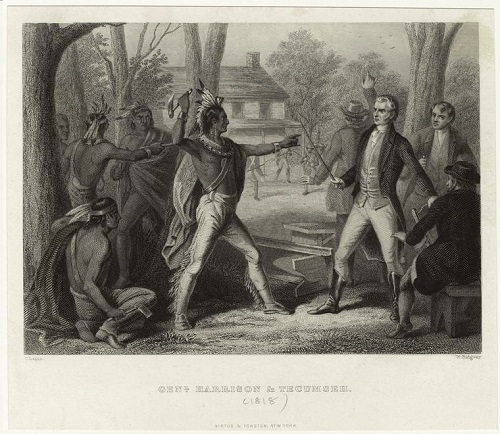In 1811, the Shawnee Chief Tecumseh tried to negotiate with the American government to stop western expansion into native lands. He formed a confederacy of native tribes and represented the interests of many natives. When negotiation failed and violence erupted, Tecumseh fled north to ally with the British.
“I want the present boundary line to continue … should you cross it … I assure you it will be productive of bad consequences.” —Shawnee leader Tecumseh

John Reuben Chapin and William Ridgway (engraver), circa 1818.
Beginning in 1808, the Shawnee leader Tecumseh travelled throughout the United States gathering supporters and allies to form a native confederacy that could resist westward expansion by white settlers. In August 1811, Tecumseh met with Governor William Henry Harrison to discuss the recent treaties, land purchases, and violence throughout the Indiana territories. At their meeting, Tecumseh spoke for a large group of natives along the Great Lakes, and told Harrison, “that piece of land, we do not wish you to take it,” indicating that his allies wanted “the present boundary line to continue.” Should the whites continue their expansion into the region, Tecumseh warned, “I assure you it will be productive of bad consequences.”
The meeting ended without resolution. Harrison understood the dangerous potential of Tecumseh’s confederacy, and wrote to the Secretary of War that “The implicit obedience and respect which the followers of Tecumseh pay to him is really astonishing.” He called Tecumseh “one of those uncommon geniuses, which spring up occasionally to produce revolutions and overturn the established order of things.” While Tecumseh continued to negotiate peace and unity between native tribes, Harrison petitioned the U.S. government for more soldiers, and made plans to intimidate and break up the confederacy.
In July 1811, Tecumseh travelled south to recruit more allies. First, he met with Harrison, who reported that Tecumseh “wished everything to remain in its present situation until his return—our settlements not to progress further.” Although Tecumseh continually proposed peace and refrained from attacking white settlements, Harrison’s spies reported that Tecumseh’s followers were preparing for war.
With Tecumseh away meeting with other native leaders, Harrison decided to take advantage. “His absence,” Harrison noted, “affords a most favorable opportunity for breaking up his Confederacy.” In November 1811, Harrison’s army marched to Prophetstown, the headquarters of the Confederacy. Although native warriors launched a surprise attack as Harrison’s troops approached, the soldiers fought back successfully, and then burned the town.
When Tecumseh returned, he concluded that any chance for peace with the white settlers had vanished. With his remaining followers, he set out for Upper Canada. He planned to meet the British officers and negotiate an alliance against the Americans. By continuing to expand onto their lands, repeatedly revising treaty boundaries, and finally by attacking them outright, white Americans had driven the native confederacy to ally with the British.
Last updated: August 15, 2017
